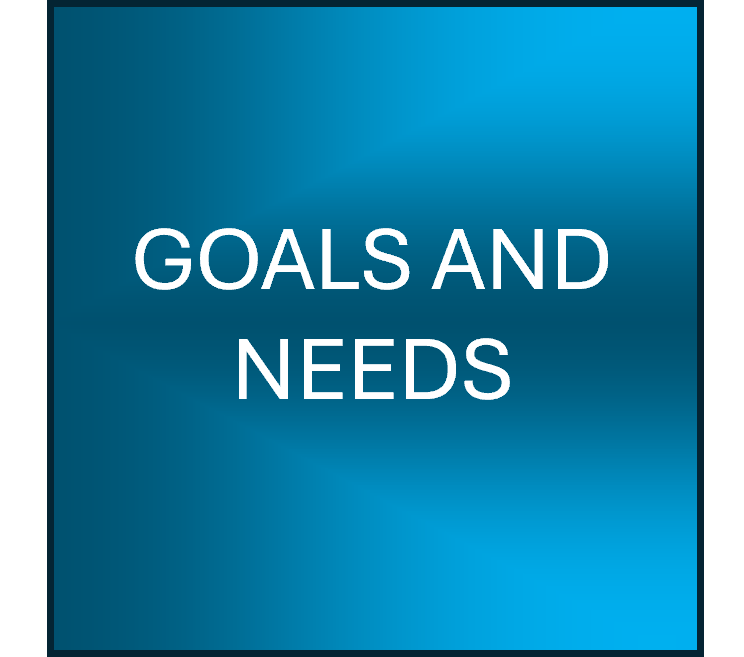
Item 1 of the 17 Competencies marking sheet

Item 1 of the 17 Competencies marking sheet
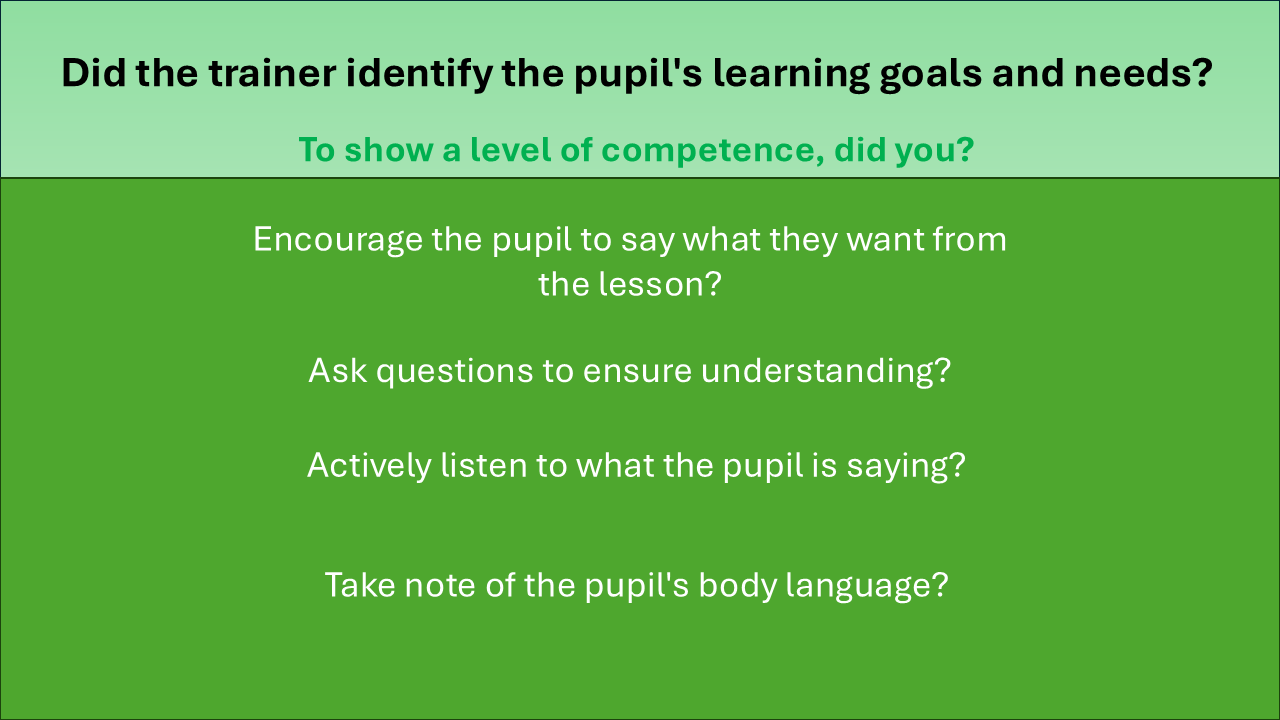
These are examples of what you should be doing
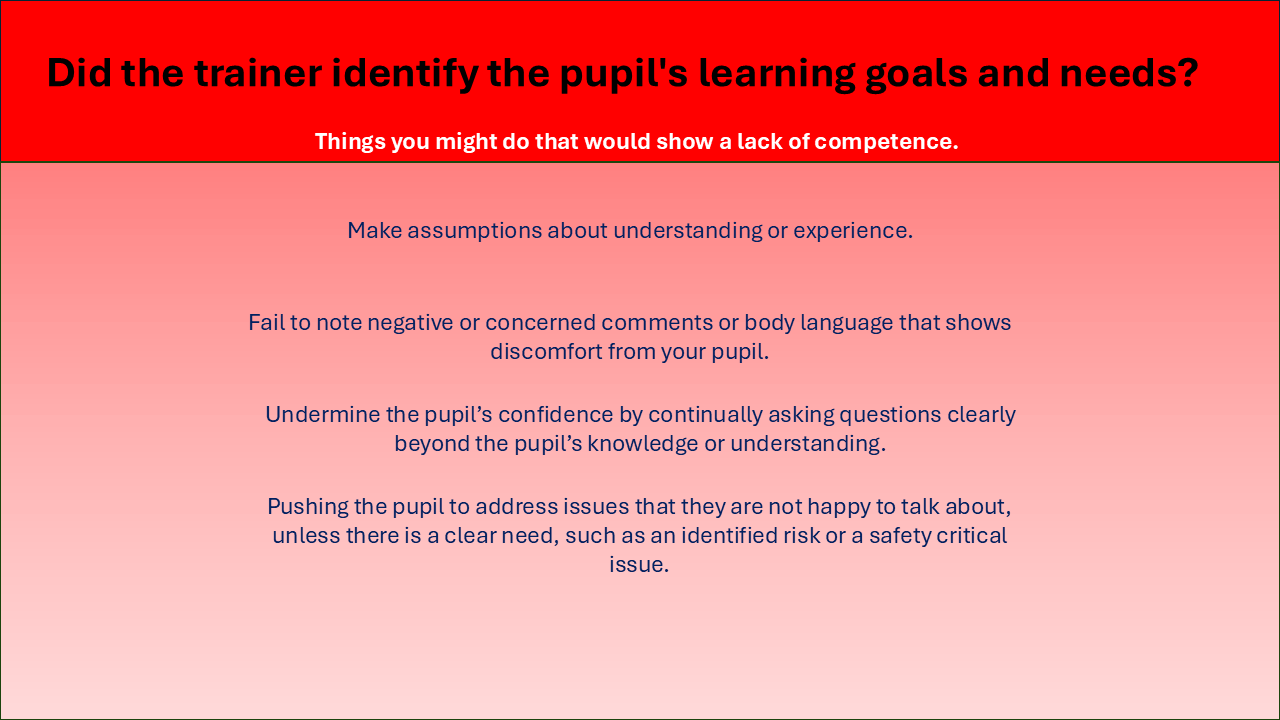
These are examples of what you should NOT be doing
DID THE TRAINER IDENTIFY THE PUPIL'S LEARNING GOALS AND NEEDS?
Usually this process will take place at the beginning of a session. However, where the PDI and the pupil have been working together for some time prior to a standards check or Part 3 they may have already laid down the basic structure of the pupil's learning goals.
This need to be taken into account by an examiner when assessing this element.
If the PDI has not worked with the pupil before it is perfectly OK for the PDI to ask the pupil to undertake a demonstration / assessment drive. This should give the PDI a good idea of the pupil's level of competence and provide a basis for discussion of the pupil's needs.
It is also important to remember that a better understanding of the pupil's needs may emerge as the lesson progresses. It follows that this criteria cannot be 'ticked-off' at the beginning of the lesson and then forgotten.
As an examiner observes the lesson, they will be looking for indications that the elements, which go to make up the low-level competence, are being demonstrated,. In this case the sorts of things that would give them an indication of competence include:
* Encouraging the pupil to say what they want from the lesson.
* If early in the learning process, ensuring there is understanding about responsibility for managing risk.
* Asking questions to ensure understanding.
*Checking understanding as the lesson progresses.
* Listening to what the pupil is saying.
* Taking note of body language.
If a PDI encourages the pupil to say what they want, asks questions to check understanding at the beginning and as the lesson progresses, listens to what they are saying and picks up on body language they are likely to get a 3. If on the other hand, they do all the listening bits but fail to spot the learner getting very tense and nervous in a particular situation they would probably get a 2. They have demonstrated their understanding of the need to listen etc, but have not yet developed their ability to spot non-verbal clues. Indication of a lack of competence could include:
* Making assumptions about understanding or experience.
* Failing to note negative or concerned comments or body language that shows discomfort.
* undermining the pupil's confidence by continually asking questions clearly beyond the pupil's understanding or knowledge.
* Pushing the pupil to address issues that they are not happt to talk about, unless there is a clear need, such as an identified risk or a safety critical issue.
Goals and Needs.
Are specific to your pupil. The goal and needs are what they would like to have achieved during a lesson or within a set period of time, and not what you want them to have achieved.
If the instructor is leading the goal, it would be deemed "Teaching goals" rather than when the pupil chooses the goal it would then be deemed "Learning goals"
Client-Centred goals need to be led by the pupil.
So your lessons ideally should be set around your pupils needs and their current abilities.
Create two-way conversations with your pupils to understand what their needs are, to learn and grow to be able to build on their current skills and abilities.
Occasionally, and until you have created a rapport with your pupil, you may find that they are very limited in their conversation with you. On these occasions it may be necessary for you to work out your pupils current ability as create some goals for them. You will understand what they are capable of and will be able to gauge what they need to progress with their learning journey.
Obviously, talk through with your learners on these occasions what your intentions to help them grow are, and even if they won't talk to you, you could get a thumbs up or thumbs down from them whether they are happy to continue with that particular goal.
Very rarely you are going to get times where your pupil is non verbal throughout their learning journey.
This is when you will need to work a programme of goals and needs for your pupil based on their current ability.
If they are non verbal, you can still get consent from them by means of a thumbs up or down, or a yes/no sheet.
But it is an instructors responsibility to ensure that should the lesson goals and needs have to be set up by them, that a mutual agreement is made between yourself and your pupil.
Adaption is a key skill for good instructors.
It doesn't matter whether the pupil is a new learner, a full licence holder or someone who is looking at becoming an instructor.
If the session is to be Client-Centered the goal needs to be led by the pupil.
As a guide, pupils that lead their goals and needs will tend to learn quicker as they tend to set the level that they work on based around their own feelings of ability.
Obviously, there still needs to remain a two way road of communication between you and your pupil if they are trying to exceed their actual abilities.
You could consider two options for Goals. "Planning goals and Outcome goals"
Planning goals could be deemed as a "Plan of action to achieve a particular goal".
The plan might be something like wanting to achieve a good standard of driving on a motorway.
The Outcome goal would be when this has been achieved.
It may be quite a few planning goals that take place before a pupil has reached their outcome goal.
However, based on the pupil's experience and ability, it might be possible to have achieved a planning goal and outcome goal by the start and finish of one session.
If you look at it in these 2 examples.
Example one:- you have a pupil that has a good ability with driving but cannot park in reverse into a car park bay.
They understand how to control the car slowly, but have never mastered the art of effective observation and mirror use during reversing.
By being assisted with the correct timing for the use of mirrors and where to be looking during a reverse bay park the process to achieve this manoeuvre satisfactorily on every attempt may happen very quickly. Which may mean the planning goal and outcome goal is achieved on the same day.
Example two:- your pupil is a new learner and wants to be good at driving on a motorway. At their current ability and experience it would be dangerous to attempt to take a new learner onto a motorway.
Turning into roads and moving off is currently a working progress with them, so to attempt a motorway drive would not be suitable at this time.
This is when a planning goal needs to be discussed. Working out a plan of action of things that may be required to be achieved beforehand so that your pupil has the skills and ability to be able to join, drive on and leave a motorway.
So they may have quite a few Planning goals to have achieved before they reach their Outcome goal.
The Outcome goal will be achieved once they are capable of driving on a motorway with ease.
SMART GOALS are a very good way to assess planning goals and outcome goals.
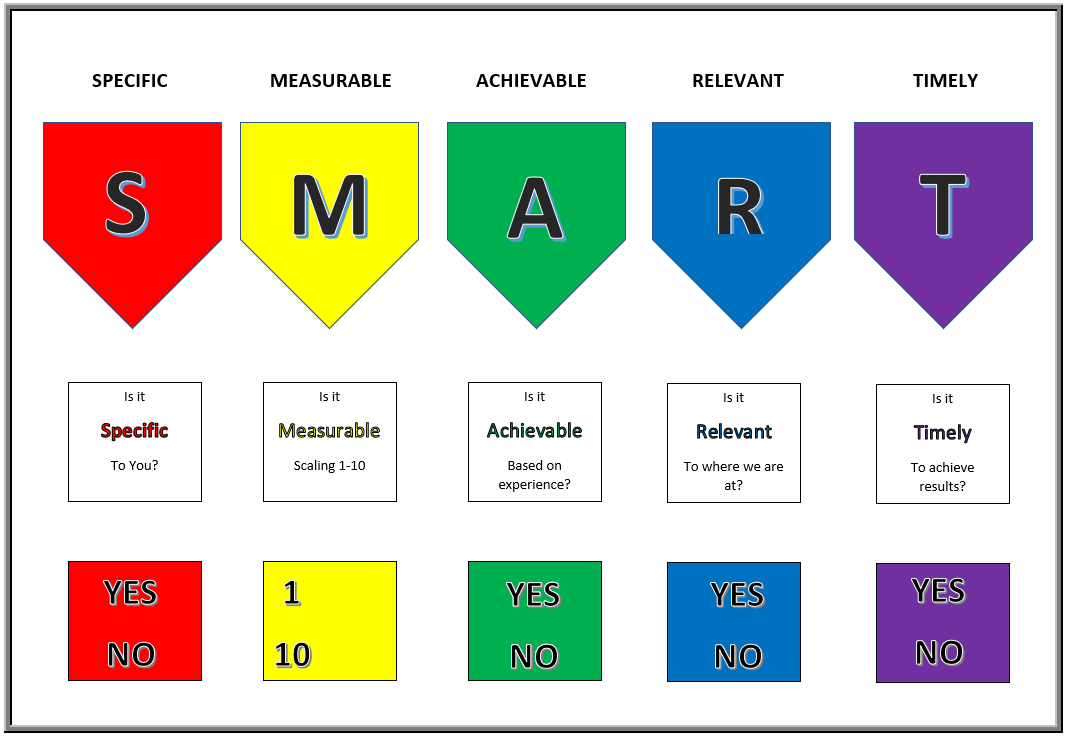
The learning objective that you are looking at should be clear and well defined.
You should be aiming to engage with your pupil to see whether the particular objective is within their capabilities at the present time.
Use this part of the SMART framework to dig in to as much content as is necessary to work out the specifics of what your pupil knows,
what they are trying to achieve, and how they are going to achieve it.
Just a simple task of coming to the stop at the end of a road can bring in so many questions.
What type of road?
Where will you need to stop?
Are you turning right?
Are you turning left?
Are you going straight ahead?
Is it a busy junction?
What is the speed limit of the road you are going to be joining?
Does it have a Give way line or Stop line?
What about if it is wet?
What about if it is night time?
How fast are you going to approach it?
Will you need to give a signal?
Is the junction Open or Closed?
These are just a fraction of possible questions that might come up in the conversation regarding the specifics of
your pupil wanting to come to a stop at the end of a road.
By the use of a scale 1 to 10
1 being not very good, 10 being very competent.
Ask your pupil at what scale do they current think they are.
It is irrelevant what number they choose!
It is their current understanding of their ability and NOT YOURS!
By using scaling you have the ability to discuss how between the two of you, you can build on their current level.
The learning objective should be realistic and capable of being achieved.
If you try and achieve more than your pupil is capable of it can be very demotivational and frustrating for them.
Building knowledge, experience and abilities can be achieved in bite sized chunks, but by trying to achieve it all in one hit could cause information overload
and have the opposite effect on the initial learning objective.
This is where a Planning Goal may need to be introduced as the learning objective may not be achieved in one session,
it may take numerous sessions to make the learning objective achievable.
The learning objective must reflect your pupils current ability.
As mentioned earlier in this section, you wouldn't be taking a new learner onto the motorway on their very first lesson as they would not be cable of achieving the goal, and it definitely would not be relevant to their current ability.
By pushing your pupil too quickly, they will become demotivated and disengaged from the learning objective.
Defining a timeline!
It may be necessary to set the timeline to more than one or more session to achieve the learning objective.
By making the pupil aware that the particular learning objective may take time will take the pressure off of them to feel that it must be achieved instantly.
Time to become competent in each learning objective is crucial to creating safe drivers. If things are rushed or not carried out in a timely manner then the skills will be watered down.
On the other hand you must ensure that the learning objective is not played out in such a manner that it becomes unengaging for your pupil. If they understand the objective and can carry it out competently then you either need to introduce a new objective or increase the level of the current objective so that is begins to challenge your pupil.
This may mean moving location to busier roads or faster moving roads etc.
By using SMART objective you will provide clear and concise goals. This will aid your pupils in the understanding of what is required of them, ensure they remain engaged during your sessions, and allow them to see where learning is taking place.
The scaling at the start and end will show this, and will allow you to constantly reassess where they are and find out what could be changed or done differently to make their scale a larger number.
When your learner scales their current ability it is very likely that they will tend to score higher than you believe them to be.
By entering into a discussion with them without undermining them (SO DON'T SAY YOU THINK THEY ARE A 3, IF THEY THINK THEY ARE A 7), you can help them to understand that maybe there are things missing from their skill set that would maybe make them bring that score down, but don't force them to bring the score down, let them make the decision to say maybe they think their initial score was a little high.
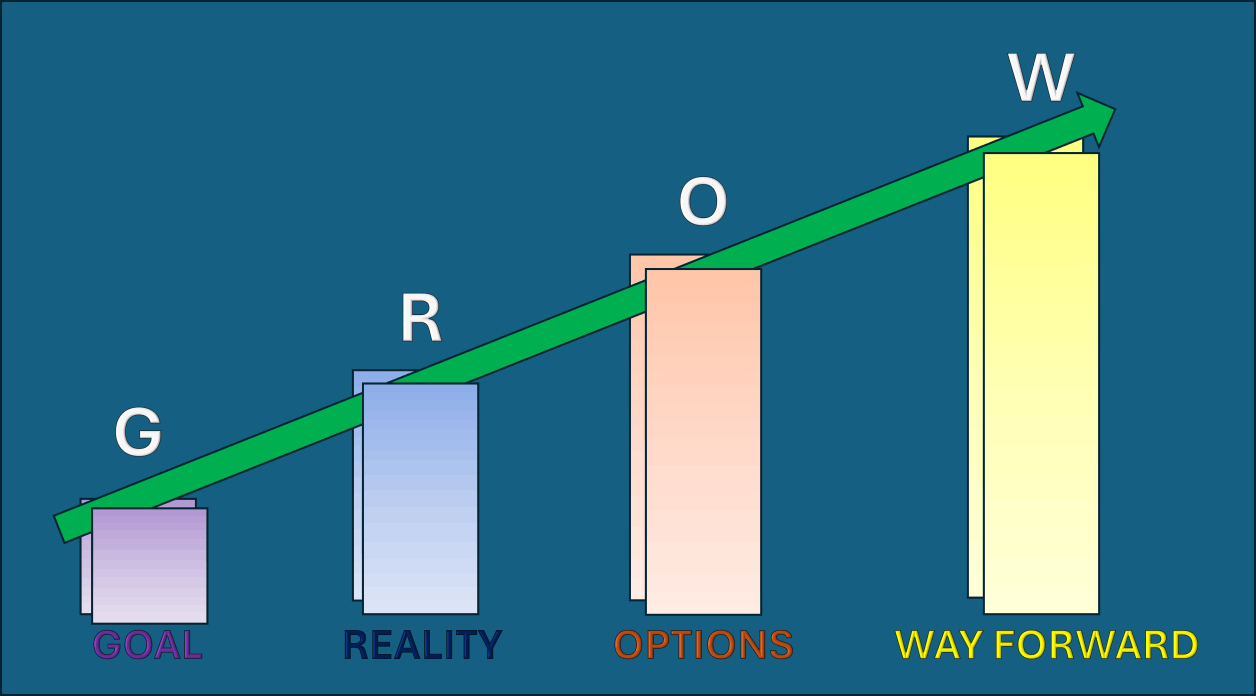
The basis of this is to allow your learner to find a subject that they would like to learn (it may be new, or it may be something they want to improve on)
That's their goal!
You then need to find out what their current reality is regarding that goal.
Do they know anything about it, or is it something totally new to them?
Delve deep into their mind by asking open questions that may evoke awareness of something they may have never given thought to before.
Silence after the question is important at this stage, to give them time to think!
Only ask one question at a time, as our brains can only truly process one thing at a time productively.
You'll then get to the Options stage.
What options do they have?
What help with they need from you?
How would they like to go about achieving this?
When would they like to have achieved this by?
What will they feel like when they have achieved it?
Find out as much as you can, which involves your pupils' thought process more than it involves you, if you can. Get them thinking!
Obviously, if they draw a blank, then you haver to fill in the gaps. But give them time to think, give them different questions in a way that may change their thinking, don't just jump in with the answer! they will thank you for it in the end.
A thinking driver will end up working things out for themselves, a driver who is told everything will struggle when you're not there.
And then finally on to the way forward.
How will they know when they have achieved their goal?
What will that look like?
How will they feel?
What might get in the way?
What could they do to ensure that the goal is met?
Who else might be able to help them?